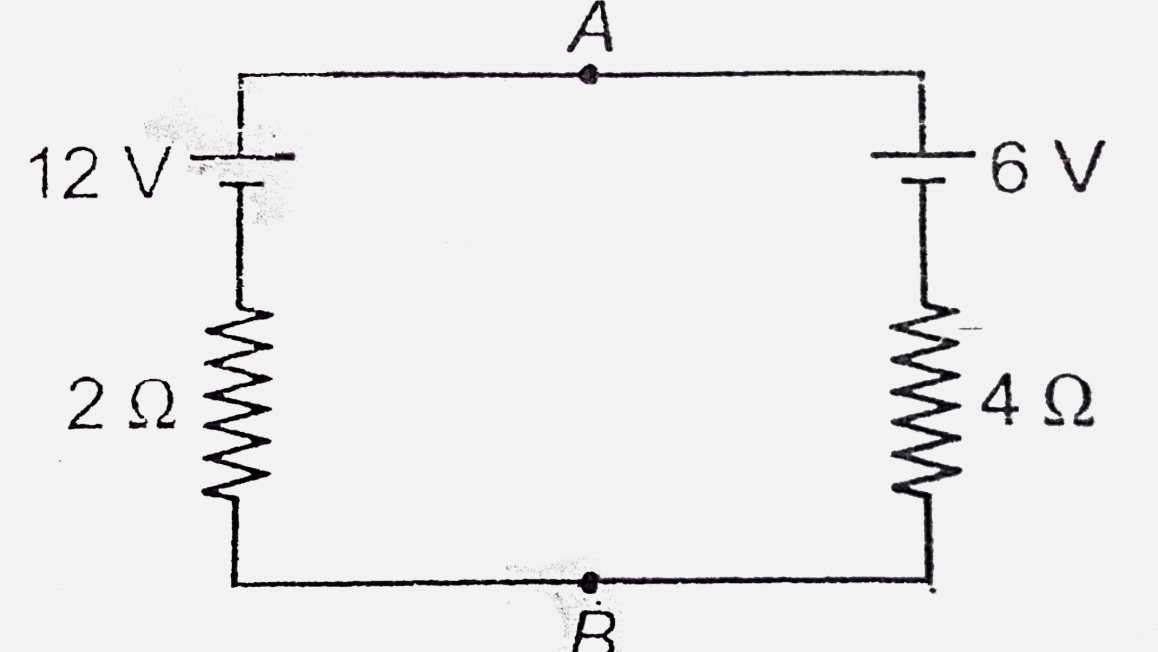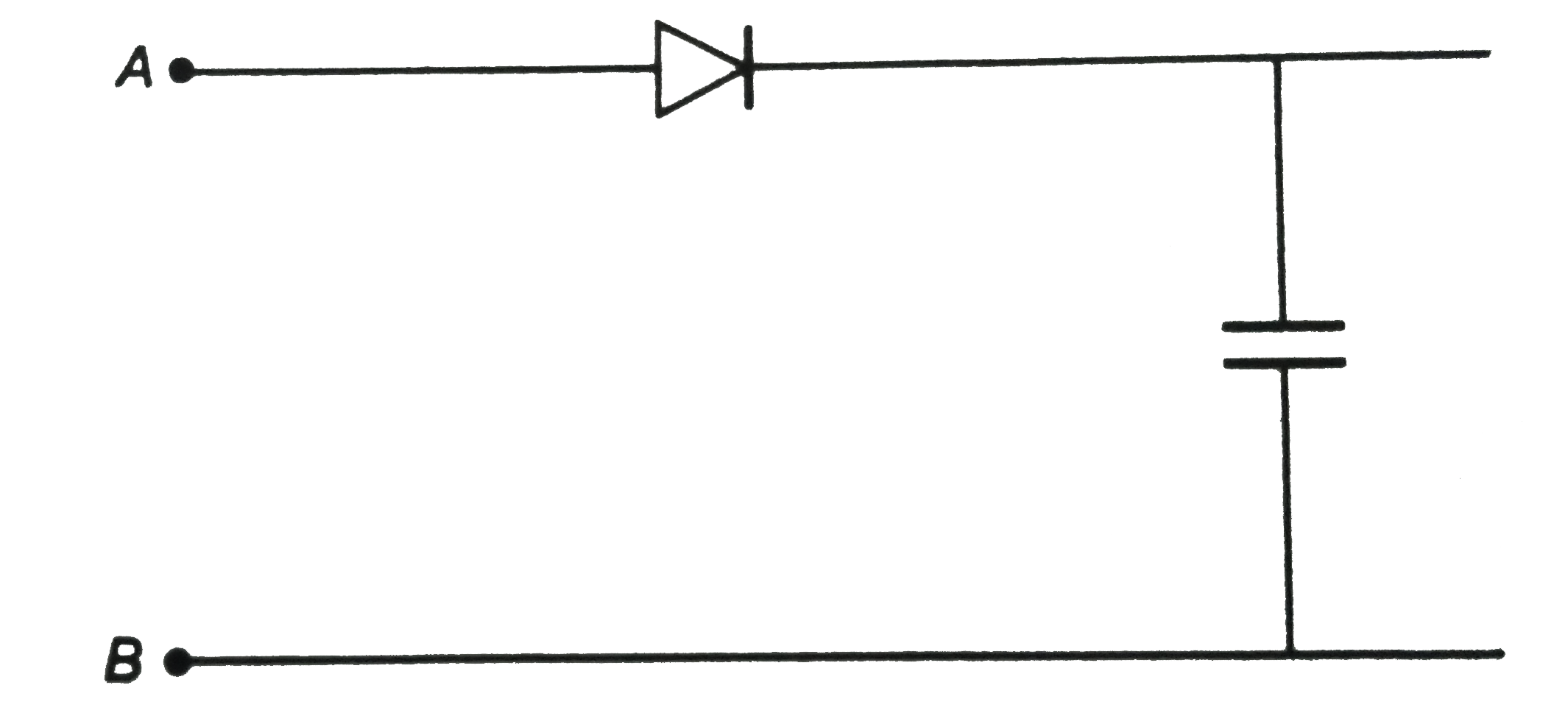Two, capacitors A and B are connected in series across a 100V supply and it is observed that the potential difference across them are 60V and 40V. A capacitor of 2pF capacitance is now connected in parallel with A and the potential difference across B rises to 90V. Determine the capacitance of A and B
The correct Answer is:B, D
To solve the problem, we need to determine the capacitances of capacitors A and B based on the given information. Let's break it down step by step.
Step 1: Understand the Initial Conditions
We have two capacitors, A and B, connected in series across a 100 V supply. The potential difference across A is 60 V, and across B is 40 V.
Step 2: Use the Relationship of Capacitors in Series
For capacitors in series, the charge (Q) on each capacitor is the same. The relationship between capacitance (C), charge (Q), and voltage (V) is given by:
Q=C⋅V
From this, we can express the capacitances in terms of the voltages:
CA=QVAandCB=QVB
Since Q is the same for both capacitors, we can write:
CACB=VBVA
Substituting the values we have:
CACB=4060=23
Step 3: Express C_A in Terms of C_B
From the above relationship, we can express CA in terms of CB:
CA=23CB
Let’s call this Equation (1).
Step 4: Analyze the New Configuration
Now, a capacitor of 2 pF is connected in parallel with capacitor A. The new capacitance of A becomes:
C′A=CA+2pF
The potential difference across B rises to 90 V, and we need to find the new potential difference across A:
Since the total voltage remains 100 V, we can find the new voltage across A:
V′A=100V−V′B=100V−90V=10V
Step 5: Set Up the New Relationship
Using the same relationship for capacitors in series again:
C′ACB=V′BV′A
Substituting the known values:
CA+2CB=9010=9
Step 6: Substitute C_A from Equation (1)
Now substitute CA from Equation (1):
23CB+2CB=9
Step 7: Solve for C_B
Cross-multiplying gives:
23CB+2=9CB
Rearranging terms:
2=9CB−23CB
2=(9−23)CB
To combine the terms:
9=273
So:
9−23=273−23=253
Thus:
2=253CB
Multiplying both sides by 325:
CB=2⋅325=625pF
Step 8: Calculate C_A
Now substitute CB back into Equation (1):
CA=23CB=23⋅625=1275=425pF
Final Answer
Thus, the capacitances are:
- CA=425pF or 0.16pF
- CB=625pF or 0.24pF
We have two capacitors, A and B, connected in series across a 100 V supply. The potential difference across A is 60 V, and across B is 40 V.
For capacitors in series, the charge (Q) on each capacitor is the same. The relationship between capacitance (C), charge (Q), and voltage (V) is given by:
Q=C⋅V
CA=QVAandCB=QVB
CACB=VBVA
CACB=4060=23
From the above relationship, we can express CA in terms of CB:
CA=23CB
Let’s call this Equation (1).
Now, a capacitor of 2 pF is connected in parallel with capacitor A. The new capacitance of A becomes:
C′A=CA+2pF
Since the total voltage remains 100 V, we can find the new voltage across A:
V′A=100V−V′B=100V−90V=10V
Using the same relationship for capacitors in series again:
C′ACB=V′BV′A
CA+2CB=9010=9
Now substitute CA from Equation (1):
23CB+2CB=9
Cross-multiplying gives:
23CB+2=9CB
Rearranging terms:
2=9CB−23CB
2=(9−23)CB
To combine the terms:
9=273
So:
9−23=273−23=253
Thus:
2=253CB
Multiplying both sides by 325:
CB=2⋅325=625pF
Now substitute CB back into Equation (1):
CA=23CB=23⋅625=1275=425pF
Thus, the capacitances are:
- CA=425pF or 0.16pF
- CB=625pF or 0.24pF
Topper's Solved these Questions
- CAPACITORSBOOK - DC PANDEY ENGLISHCHAPTER - CAPACITORSEXERCISE - OBJECTIVE_TYPE
1 Video
- CAPACITORSBOOK - DC PANDEY ENGLISHCHAPTER - CAPACITORSEXERCISE - OBJECTIVE_TYPE
1 Video
- ATOMSBOOK - DC PANDEY ENGLISHCHAPTER - ATOMSEXERCISE - MEDICAL ENTRANCES GALLERY
42 Videos
- COMMUNICATION SYSTEMBOOK - DC PANDEY ENGLISHCHAPTER - COMMUNICATION SYSTEMEXERCISE - Subjective
11 Videos
Similar Questions
Potential difference across AB , i.e., VA−VB is

View SolutionTwo capacitors of capacitance 6µF and 4 µF are put in series across a 120 V battery. What is the potential difference across the 4 µF capacitor. (a) 72 V (b) 60 V (c) 48 V (d) zero
View SolutionTwo capacitors of capacitance 6µF and 4 µF are put in series across a 120 V battery. What is the potential difference across the 4 µF capacitor. (a) 72 V (b) 60 V (c) 48 V (d) zero
View SolutionA 220 V AC supply is connected between points A and B . What will be the potential difference V across the capacitor ?

View SolutionA 220 V AC supply is connected between points A and B . What will be the potential difference V across the capacitor ?

View SolutionA 220 V AC supply is connected between points A and B . What will be the potential difference V across the capacitor ?

View SolutionRows of capacitors 1,2,4,8…..∞ capacitors, each of capacitance 2μF, are connected in parallel as shown in figure. The potential difference across AB = 10 V, then

View SolutionThree capacitors 3μF,6μF and 6μF are connected in series to source of 120 V. The potential difference in volt, across the 3μF capacitor will be
View SolutionTwo capacitors of capacitances 20.0pF and 50.0pF are connected in series with a 6.00V bettery . Find (a )the potential difference across each capacitor and (b) the energy stored in each capacitor .
View SolutionIf A is connerted with D and B is connected with C find the potential difference a across each capacitor and the final charge in each capacitor.
View Solution